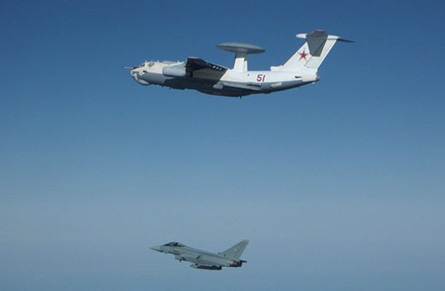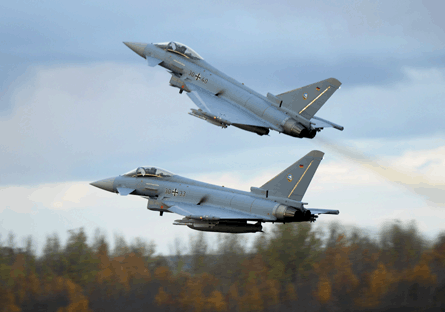It has been a long time since we have heard the "yesterday's aircraft at tomorrow's prices" jibe thrown at Eurofighter, but those who still insist that the air superiority fighter is a "Cold War relic" may be missing something critical: the Cold War itself has not entirely gone away.
Proof came on 15 September, when two German air force Eurofighters had to make an "alpha scramble" from their temporary base at Siauliai, Lithuania, while providing Baltic sector quick reaction alert/air policing duties for NATO.
The aircraft they met turned out to be a Russian air force Beriev A-50 airborne early warning and control platform, which the German pilots photographed and escorted further back into international airspace before returning to Siauliai.
 |
|---|
© Luftwaffe |
This incident, which came just two weeks into Fighter Wing 74's two-month stint at Siauliai, was certainly the most exciting moment of the deployment, and its timing was probably significant. While the Baltic QRA sector has been patrolled by NATO air forces from Siauliai since Estonia, Latvia and Lithuania joined the alliance in 2004, FW74's deployment was the first time that Eurofighters had been on duty there.
It must be assumed that the crew of the A-50 were expecting company, and had their own cameras and radar gear primed and ready for their first-ever contact with a Eurofighter. Meanwhile, approaching the German air force aircraft from behind was a pair of Russian Sukhoi Su-27 fighters, which were duly intercepted by Finnish air force fighters on QRA duty in their sector.
Such a day would have been one of high tension in 1989, but 20 years after the fall of the Berlin Wall there clearly remains no small measure of prickliness in East-West relations.
For the rest of the two-month deployment, flying involved about five training - or "tango" - scrambles a week, often involving a mock intercept of a Lithuanian air force Aero Vodochody L-39 trainer or Mil Mi-8 transport helicopter.
 |
|---|
© Geoffrey Lee/Eurofighter |
But FW74's time at Siauliai was anything but routine. Lt Col Jon Gloystein, speaking in the easy American accent typical of US-trained German air force fighter pilots, says the deployment was an important exercise in bare-base operations with the Eurofighter.
Siauliai was the biggest Soviet air base outside Russia, but when the Baltic states gained independence, the Russians literally packed up and went home. What they left behind amounted to what could not be moved: a 3,500m (11,400ft)-long runway and a scattering of hardened aircraft shelters built for Mikoyan MiG-21s.
There is a little more infrastructure than that today, but the NATO QRA headquarters is little more than a portacabin, and the four deployed Eurofighters were kept in canvas hangars.
Gloystein says the experience of operating Eurofighters far from home is invaluable when it comes to managing logistics to maximise aircraft availability, particularly requests for and delivery of spare parts.
Some spares, he notes, can only be transported by military airlift, but that is only available in Siauliai once a week. Others are rarely needed and so, in a pinch, only available by cannibalising another aircraft.
In Siauliai, FW74 had 110 personnel, with many being rotated back to the squadron's home base at Neuberg-Donau to give as many as possible of the wing's 1,100 people experience of the mission. Pilots were on a three-week rotation.
According to Gloystein, it would have been possible to run the QRA mission with just 90 people, but the deployment was also a training opportunity. In a combat situation, he says, four Eurofighters could be supported by just 60 soldiers.
All of that is a far cry from his Bavarian home base, where FW74 also carries out domestic QRA duties. With just 10 Eurofighters, the squadron was stretched very thin to meet its obligations, both of which demand at least four aircraft - two at 15min readiness and two more in reserve. Just two were left as spares.
Running lean has consequences. With only four Eurofighters in Siauliai, it was not possible to fly enough hours to keep all FW74's pilots' licences current. As a result, Germany had to split its four-month Baltic deployment into a pair of two-month sections, with the November-December period picked up by the McDonnell Douglas F-4 Phantoms of the Wittmund-based and gloriously-named FW71 "Richthofen".
The German air force generally is having to make do with fewer aircraft than expected, because some of its Tranche 1 aircraft were diverted for delivery to launch export customer the Austrian air force. Gloystein says operating with too-few aircraft hurts when others "are taken from your own flesh".
Being short of aircraft even means pilots have to fill some time with non-flying duties, which can include periods in Afghanistan. Gloystein admits this situation poses a challenge to morale, but stresses that "above all they are officers and soldiers".
Despite winter conditions at Siauliai, FW74 managed 100% Eurofighter readiness over several weeks - a performance "unmatched so far", according to German air force public affairs officer Maj Alexander Feja, who sums up the deployment as "mission accomplished".
Further ahead, Gloystein is looking forward to having German Eurofighter pilots being equipped, beginning next year, with a new digital helmet that includes voice-activated targeting. And, with any luck, they will take part in Allied flag exercises, possibly including a visit by six to eight aircraft to the US Air Force's Mountain Home AFB in Idaho.
Source: Flight International























